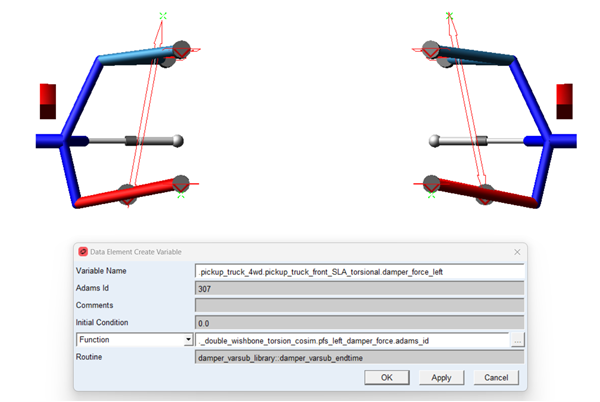Mahindra accurately predicts ride and handling performance using frequency dependent damper modelling with Machine Learning
by Lenka Visweswara Rao, Alok Thanapati and Anthonysamy Baskar, Mahindra & Mahindra Ltd.

Engineering Reality 2023 volume 2 edition
Empowering Makers for an autonomous sustainable future
Ability to incorporate test data of a frequency-dependant damper as a machine learnt entity allows for reliable ride prediction with virtual full-vehicle simulations
Modern vehicle suspension systems are carefully designed to meet best-in-class handling performance while maintaining good ride and comfort—a passive suspension compromises between good ride comfort and good handling performance. Frequency selective damper (FSD) is used to get best-in-class ride and handling performance. This study uses a quantitative method to determine the range of suspension parameters for ride comfort and handling performance. Passive dampers are modelled using a simple nonlinear curve (Force vs. Velocity), which does not correlate well with the FSD damper model.
A system is required to monitor and predict the performance of the suspension struts in real time. Machine Learning (ML) and Artificial Intelligence (AI) have been applied for modelling and predicting the FSD damper system. However, work has yet to be done to implement ML or AI for modelling and predicting the performance of hydro-pneumatic struts in SUV vehicles. As such, this current work will be a pioneering effort toward developing ML and AI models for solving this problem.
Achieving this goal involved implementing an inverse dynamics solver with neighbours = 3 and power = 2. We used ODYSSEE Integration with Quasar Embedded and MATLAB Simulink for ML/AI model development. Later, we compared the results from both ML/AI approaches. 80% of the total experimental data is used during the development and training of the models. The remaining 20% is used during the testing and validation of the developed models. The Inverse dynamics model showed the desired accuracy regarding FSD damper system performance prediction. This study showed that the machine learning approach improves the project’s ride and handling prediction development stage, reducing the testing timeline significantly.

Figure 1. Test data for training the ODYSSEE model.

Figure 2. Generate ODYSSEE model using FSD test data.

Figure 3. Embedding ODYSSEE model into Adams full vehicle model.

Figure 4. Test and ODYSSEE predicted damper force comparison.
Learning the test data with ODYSSEE CAE
ODYSSEE CAE is a unique and powerful CAE-centric innovation platform that allows engineers to apply Machine Learning, Artificial Intelligence, Reduced Order Modelling (ROM), and Design Optimisation to workflows. It allows users to benefit from modern data science technology by creating cost-efficient digital twins through real-time predictive modelling and optimisation for CAE simulation and physical test data.
Mahindra Research Valley, a research hub of Mahindra and Mahindra, is at the forefront of innovation in digital simulations to ensure that every new product is launched with careful design of various vehicle attributes to provide a pleasant experience for the customers.
In this study, the engineers wanted to incorporate suspension dampers in the Adams Car vehicle model. The damper generates a force as a function of the relative displacement, relative velocity, and relative acceleration between the two ends of the damper. Hence the damper can be characterised by measuring the above four quantities at various operating conditions using either test data or an independent system model in a 1D tool. The table below lists the data for input and output quantities. Each row represents a data point, with three inputs and one output. Specifically, the inputs are located in Ɍ3 space, while the output is in Ɍ space. Learning a closed-form response surface and implementing it can be challenging. However, the methodology developed in this case is general and extensible to N-dimensional input space.
The learning step involves feeding the test data mentioned above to ODYSSEE’s Quasar solver. The solver can iterate over the data using various Machine Learning algorithms to see which performs best for the data at hand and generates the machine learning parameters.
The learnt model from ODYSSEE Quasar is packaged as a dynamically linked library (.dll) and ported into Adams for vehicle-level simulations.
Implementation into Adams Car
With Adams Car vertical products, engineering teams can quickly build and test functional virtual prototypes of complete vehicles and vehicle subsystems. Working in the Adams vehicle vertical environment, automotive engineering teams can exercise their vehicle designs under various road conditions, performing the same tests they usually run in a test lab or on a test track, but in a fraction of the time.
In this study, the dampers in the vehicle suspension system were implemented as an Adams Single component force that acts as an action-reaction entity between the lower and upper strut attachment points. The value of this force came from a variable based on relative displacement, relative velocity, and relative acceleration measured between the endpoints of the struts. These values feed into the user subroutine (dll), and the output of the force value sent to the damper. This query about the force happens during every step in the marching simulation.
Results
The machine learning model can replicate the real damper performance with high accuracy. The more the volume of data fed into the machine learning algorithm, the better the model’s performance. The images show how the model performed compared to the true test data.
Conclusion
Mahindra Research Valley’s Vehicle Dynamics team was able to innovate using Adams and ODYSSEE to implement a frequency-dependant damper in a vehicle simulation. This task would have been highly cumbersome or outright impossible without the ability to learn the test data via ODYSSEE CAE Quasar solver and its machine learning algorithms.
“Frequency dependent damper modelling with ODYSSEE helped us to explore beyond traditional modelling of damper characteristics in MBD simulations. This gave us the impetus to incorporate more complex damper characteristics and improve the fidelity of the simulation models.”